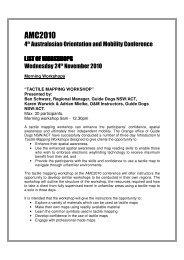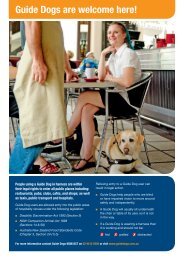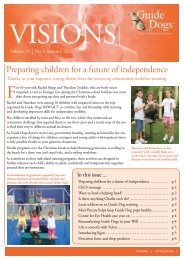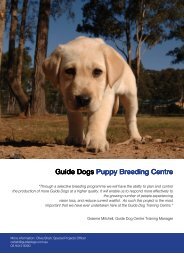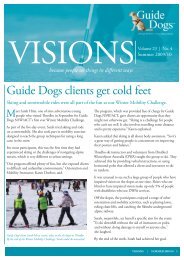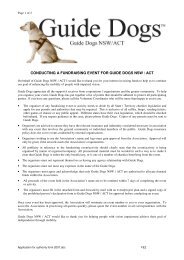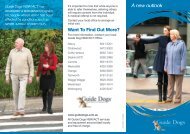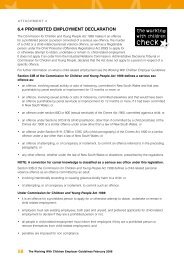AMC2010 - Guide Dogs NSW/ACT
AMC2010 - Guide Dogs NSW/ACT
AMC2010 - Guide Dogs NSW/ACT
Create successful ePaper yourself
Turn your PDF publications into a flip-book with our unique Google optimized e-Paper software.
The author will also discuss some solutions and<br />
strategies adopted over the duration.<br />
3. Title: The “Kinetic Cane”: Enhancing<br />
Independence for a Woman with Limited<br />
Arm Use<br />
Author: Beth W. Helmers, Regional Manager,<br />
<strong>Guide</strong> <strong>Dogs</strong> <strong>NSW</strong>/<strong>ACT</strong><br />
Summary: University lecturer, Diane, experienced<br />
a brain injury from a blow to the head, and two<br />
successive spinal fractures in falls, resulting in<br />
spinal damage. She is an incomplete quadriplegic<br />
and her neck is fused from C3-C7, preventing the<br />
head turning which would otherwise allow her to<br />
compensate for a visual field loss and impaired<br />
horizontal eye movement. She walks using a<br />
right forearm crutch. With her right arm occupied<br />
and having virtually no independent movement in<br />
her left arm, the challenge was to devise a cane<br />
which could assist her in locating the low objects<br />
and trip hazards which pose a constant risk to<br />
her independent movement. This study will chart<br />
Diane’s progress with an innovative, personalised<br />
mobility aid which also has applications for people<br />
who have had strokes.<br />
4. Title: “The Spring Loaded Cane”: A Cane<br />
Adaptation for a Client with RSI<br />
Author: Karyn Willins, O&M Instructor, <strong>Guide</strong> <strong>Dogs</strong><br />
<strong>NSW</strong>/<strong>ACT</strong><br />
Summary: Suzanne is a 65 year old with Spinal<br />
degeneration and Arthritis. She uses both an<br />
orthopaedic and mobility cane.<br />
Suzanne recently developed RSI in her left hand.<br />
This resulted in pain each time the cane came<br />
in contact with a rough surface or contacted an<br />
object. The challenge was to:<br />
Adapt the cane to allow body coverage, as<br />
Suzanne had limited wrist movement.<br />
Lessen the jarring felt in her wrist and arm using the<br />
“kinetic cane” as a starting point, &<br />
Ensure that the grip was returned to its original<br />
position quickly.<br />
This presentation will discuss the problems<br />
encountered during the development of this<br />
cane, and detail how those challenges were met.<br />
Attendees will be provided with instructions on how<br />
to make the cane. They will also be encouraged to<br />
“think outside the square” when meeting<br />
clients’ needs.<br />
26<br />
9:00am Session 3, Forum B: Managing<br />
challenging training programs including<br />
innovative program design structure and<br />
execution. Room: Main Common Room<br />
1. Title: Have You Got Your License? O&M with<br />
Scooters and Wheelchairs<br />
Authors: Shelley Pannier and Lil Deverell, <strong>Guide</strong><br />
<strong>Dogs</strong> Victoria<br />
Summary: Motorised mobility scooters are<br />
increasingly a part of the streetscape. O&M<br />
Specialists are sometimes asked to advise clients<br />
on the best model to purchase, or consulted about<br />
low vision considerations in relation to these aids.<br />
The authors have been liaising with various O&M<br />
providers about their recommended practices<br />
regarding scooter and wheelchair use, and believe<br />
it is important to bring together this information<br />
for the profession. A draft statement on scooter /<br />
wheelchair use will be brought to the conference,<br />
with an invitation for members of the profession to<br />
comment and provide feedback before a more final<br />
document is generated.<br />
2. Title: Challenges for Orientation and Mobility<br />
Training on Public Buses with a Low Vision<br />
Client who Mobilises in an Electric Wheelchair<br />
Author: Nathan Burford, O&M Instructor, <strong>Guide</strong><br />
<strong>Dogs</strong> <strong>NSW</strong>/<strong>ACT</strong><br />
Summary: John (pseudonym), a client with<br />
low vision and cerebral palsy, mobilises in an<br />
electric wheelchair. Following prior training and<br />
experience with Miniguide travel, John sought<br />
further independent travel opportunities with public<br />
(wheelchair accessible) buses.<br />
This paper will explore how, for this particular client,<br />
the utilisation of bus travel, and the associated<br />
potential for independence that bus travel offered,<br />
raised a variety of challenges for the delivery<br />
of O&M services, in particular: program design<br />
and delivery; sequence of skill acquisition and<br />
instruction; access/advocacy issues; and defining<br />
instructor role/parameters of service delivery.<br />
3. Title: Is Long Cane Instruction Enough?<br />
Investigating the Benefits of Physiotherapy<br />
Assessment & Intervention in an Orientation<br />
and Mobility Program<br />
Author: Karen Warwick, O&M Instructor, <strong>Guide</strong><br />
<strong>Dogs</strong> <strong>NSW</strong>/<strong>ACT</strong><br />
Summary: The following paper is a case study of a<br />
7 year old child with a significant congenital vision<br />
loss undergoing long cane instruction. Up until<br />
the age of 4, this child remained at home and did<br />
not participate in any early intervention services.<br />
Meeting the family for the first time at the age of 4,<br />
it was determined the child would benefit from long<br />
cane instruction; however, it became apparent that<br />
this instruction alone did not appear to fully address<br />
the child’s gross motor deficiencies. The purpose of<br />
this paper is to further explore the possible benefits<br />
of incorporating a specific set of physiotherapy



